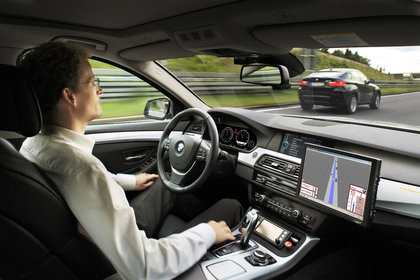
24/01/2017
Connected cars and the smart mobility revolution: variables and opportunities
Dino Collazzo
Self-driven, always connected and able to communicate with people, objects and surrounding infrastructures. Connected cars are bound to change the automotive market as well as the aftermarket. A challenge for vehicle manufacturers, traditional OEMs and hi-tech enterprises, wherein “cyber security” will play a crucial role.
Smart cars and autonomous vehicles can no longer be considered wishful thinking, they are real. And, as the first “connected cars” are now starting to circulate on our roads, allowing motorists to log on to the internet while travelling, through a number of digital tools and apps already installed in their vehicles, the next step is a 360° connectivity to anything that is outside the vehicle. Freeways now have Wi-Fi coverage and 5G signals, city traffic lights will warn motorists about possible traffic jams, not to mention danger alert systems. The dawning of a “smart world” isn’t so far after all. For some time now, the EU has focused its attentions on networking both transport vehicles and road infrastructures with the goal of completing the process by the end of 2019. A revolution that will involve not only traditional manufacturers but other industrial sectors as well. It is no coincidence, in fact, that IT giants have recently made their entrance in the automotive world, offering all sorts of cutting edge software and digital services to be installed on our cars.
As so often happens though, every change carries a number of variables with it. And as far as connected and self-driving vehicles are concerned, the hot topics, as highlighted during the 2016 Bologna Motor Show, relate first of all to cyber security, liability insurance as well as vehicle know-how and usage by the average motorist. According to a recent research performed by Tns and The bearing point institute, in seven European countries, as many as six car owners out of ten consider networking, infotainment and drive assist systems a strong buying incentive. If it is true that, according to other studies, by 2021 eight out of ten vehicles will be connected, it is equally noteworthy that the vast majority of end users are still lacking the necessary awareness of what a vehicle of this type can actually do. In fact, only four out of ten motorists (39%) are conscious of the fact that their cars already have many of these functions installed. Making these gadgets and software more intuitive, user friendly and cyber safe is the challenge facing the automotive industry as well as the aftermarket in the near future. In practical terms, this involves following the path already set by mobile phone companies which turned a “simple” mobile phone into a versatile, multi-tasking and always connected smartphone.
Building a totally connected and autonomous vehicle is a rather complex endeavor. And to complicate matters even further, a number of IT giants, such as Google, Apple and Samsung as well as hi-tech start-ups, have recently started competing with traditional manufacturers and OEM suppliers – only a few weeks ago Harman’s takeover by Samsung hit the news. Their arrival on the market produced a twofold result: on the one hand, a greater focus on developing new and innovative solutions, while on the other it forced traditional manufacturers and suppliers to review their ability to keep up with technological developments, considered to be far too slow. By technological development, we mean the ability to produce vehicles capable of communicating directly with surrounding objects and systems such as road infrastructures, other vehicles or even people. Or the ability to produce and send data, on possible malfunctions or damages, directly to the workshop that will repair them in remote.
All these new ideas, along with the tendency by so called millennials to rely more on car sharing schemes than in buying their own vehicle, will greatly influence the industry’s income in the near future. According to a recent survey carried out by Strategy&, a PwC strategy consulting team, from 2017 to 2022 we will witness different growth rates between emerging and western markets, with the former recording a growing demand for new cars and other vehicles, while the latter will experience a rather stable scenario if not a slight decrease. In time, a decline in the profits generated by new car sales will become evident globally, with a consequent increase in profits linked to car repair and maintenance services, something made possible by the on-board presence of software and hi-tech components able to be updated in remote. Just think of systems such as AEB (autonomous emergency braking), Remote Maintenance, Advanced Driver Assistance System (ADAS), Human-Machine Interface (HMI), infotainment, online access and e-commerce channels. Services that are currently offered on a one-off basis but could be subscribed to, in the near future, as aftermarket systems, or made available as smartphone apps.
As so often happens though, every change carries a number of variables with it. And as far as connected and self-driving vehicles are concerned, the hot topics, as highlighted during the 2016 Bologna Motor Show, relate first of all to cyber security, liability insurance as well as vehicle know-how and usage by the average motorist. According to a recent research performed by Tns and The bearing point institute, in seven European countries, as many as six car owners out of ten consider networking, infotainment and drive assist systems a strong buying incentive. If it is true that, according to other studies, by 2021 eight out of ten vehicles will be connected, it is equally noteworthy that the vast majority of end users are still lacking the necessary awareness of what a vehicle of this type can actually do. In fact, only four out of ten motorists (39%) are conscious of the fact that their cars already have many of these functions installed. Making these gadgets and software more intuitive, user friendly and cyber safe is the challenge facing the automotive industry as well as the aftermarket in the near future. In practical terms, this involves following the path already set by mobile phone companies which turned a “simple” mobile phone into a versatile, multi-tasking and always connected smartphone.
Building a totally connected and autonomous vehicle is a rather complex endeavor. And to complicate matters even further, a number of IT giants, such as Google, Apple and Samsung as well as hi-tech start-ups, have recently started competing with traditional manufacturers and OEM suppliers – only a few weeks ago Harman’s takeover by Samsung hit the news. Their arrival on the market produced a twofold result: on the one hand, a greater focus on developing new and innovative solutions, while on the other it forced traditional manufacturers and suppliers to review their ability to keep up with technological developments, considered to be far too slow. By technological development, we mean the ability to produce vehicles capable of communicating directly with surrounding objects and systems such as road infrastructures, other vehicles or even people. Or the ability to produce and send data, on possible malfunctions or damages, directly to the workshop that will repair them in remote.
All these new ideas, along with the tendency by so called millennials to rely more on car sharing schemes than in buying their own vehicle, will greatly influence the industry’s income in the near future. According to a recent survey carried out by Strategy&, a PwC strategy consulting team, from 2017 to 2022 we will witness different growth rates between emerging and western markets, with the former recording a growing demand for new cars and other vehicles, while the latter will experience a rather stable scenario if not a slight decrease. In time, a decline in the profits generated by new car sales will become evident globally, with a consequent increase in profits linked to car repair and maintenance services, something made possible by the on-board presence of software and hi-tech components able to be updated in remote. Just think of systems such as AEB (autonomous emergency braking), Remote Maintenance, Advanced Driver Assistance System (ADAS), Human-Machine Interface (HMI), infotainment, online access and e-commerce channels. Services that are currently offered on a one-off basis but could be subscribed to, in the near future, as aftermarket systems, or made available as smartphone apps.






